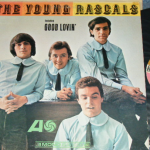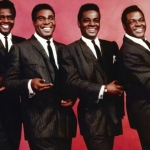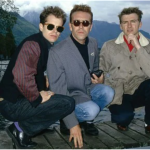“Who Can It Be Now?” – Men at Work

Released in 1981, “Who Can It Be Now?” by Men at Work is a standout track that captures the band’s unique blend of rock, new wave, and reggae influences. Written by lead vocalist Colin Hay, the song explores themes of paranoia, social anxiety, and the desire for solitude. Its catchy melody, distinctive saxophone riff, and thought-provoking lyrics have made it a lasting favorite among fans and a defining hit of the early 1980s.

The song opens with an iconic saxophone riff played by Greg Ham, which immediately sets a whimsical yet slightly tense tone. This riff is one of the most recognizable elements of the song and serves as a perfect introduction to its quirky and somewhat anxious atmosphere. The saxophone’s playful yet insistent sound complements the lyrical content, which delves into feelings of paranoia and the fear of unwanted intrusion.
Lyrically, “Who Can It Be Now?” revolves around the protagonist’s apprehension about visitors knocking on his door. The chorus, “Who can it be knocking at my door? / Go ‘way, don’t come ’round here no more,” reflects a desire for isolation and a strong aversion to unexpected social interactions. This repeated refrain captures the essence of the song’s theme, emphasizing the protagonist’s anxiety and longing for peace and solitude.

The verses further develop this theme by painting a vivid picture of the protagonist’s state of mind. Lines such as “Is it the man come to take me away? / Why do they follow me?” suggest a deep-seated fear of being watched or pursued, adding a layer of psychological complexity to the narrative. The lyrics effectively convey a sense of unease and mistrust, making the listener empathize with the protagonist’s plight.
Colin Hay’s vocal performance is crucial to conveying the song’s emotional depth. His delivery is both expressive and nuanced, capturing the tension and paranoia that underpin the lyrics. Hay’s distinctive voice, with its blend of sincerity and quirkiness, adds authenticity to the song’s narrative, making the protagonist’s fears and anxieties feel real and relatable.

Musically, “Who Can It Be Now?” is characterized by its catchy and rhythmic composition. The combination of rock, new wave, and reggae influences creates a unique sound that sets Men at Work apart from other bands of the era. The interplay between the driving rhythm section, melodic guitar lines, and prominent saxophone gives the song a dynamic and engaging quality. The production, handled by Peter McIan, is crisp and polished, ensuring that each element of the song shines through.
The music video for “Who Can It Be Now?” directed by Tony Stevens, further enhances the song’s impact with its humorous and slightly surreal imagery. The video features Colin Hay in various scenes of isolation and anxiety, mirroring the song’s lyrical themes. The playful yet poignant visuals add another layer of meaning to the song, highlighting the protagonist’s struggle with paranoia and the desire for privacy.
“Who Can It Be Now?” was a commercial success, reaching the top of the charts in several countries, including the United States, where it became Men at Work’s first major hit. Its blend of catchy melody, memorable lyrics, and distinctive sound resonated with audiences worldwide, establishing the band as one of the leading acts of the early 1980s.
In conclusion, “Who Can It Be Now?” by Men at Work is a quirky and engaging song that explores themes of paranoia and social anxiety. Through its memorable saxophone riff, thought-provoking lyrics, and expressive vocal performance, the song captures the protagonist’s desire for solitude and fear of intrusion. Its enduring popularity and impact underscore its status as a classic hit that continues to captivate listeners and showcase Men at Work’s unique musical style.












